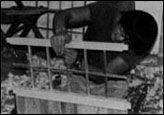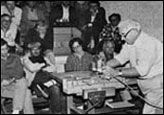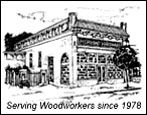|
|
Ask the Staff
Question:
I have a kitchen table and chairs that have the original stain and finish on them, and I would like to give them a worn, distressed look. A friend suggested I use milk paint. Is such a product suitable for furniture and functional pieces? How do I create a distressed appearance?

 Answer:
Prior to about the mid-1800s, paint
was not commercially available. Therefore, most people mixed up
their own paint out of whatever materials were readily available.
One of the most popular formulas was milk paint, a durable and long-lasting
finish made up of milk protein, lime and natural pigments.
Answer:
Prior to about the mid-1800s, paint
was not commercially available. Therefore, most people mixed up
their own paint out of whatever materials were readily available.
One of the most popular formulas was milk paint, a durable and long-lasting
finish made up of milk protein, lime and natural pigments.
Today, the milk paint formulation has been reproduced in an easy-to-use,
dry powder mix. Our
Old-Fashioned Milk
Paint
is an ideal product for antique and reproduction furniture
and woodwork, or even for painting the entire house. It is available
in 16 rich, earth-tone colors that can also be inter-mixed, and
has a unique texture that cannot be duplicated with today's commercial
paints.
Milk Paint needs a porous surface to adhere to, so we recommend
using
Extra-Bond
on anything other
than bare wood. On previously finished surfaces and non-porous surfaces
such as hardwoods with tight, closed grain, Extra-Bond in your first
coat of paint will greatly help adhesion.

 For
most jobs use a one-to-one ratio of water to paint powder. Add the
paint powder to the water, mixing as you pour until you've achieved
the desired consistency. Two coats of a creamy consistency will
yield a solid, opaque coating. To make a wiping stain or wash that
allows the wood grain to show through, add more water for a thinner
consistency. Milk paint can be applied using a brush, roller
or spray equipment, or a rag and sponge can be used to create special
textures and effects on walls and other surfaces.
For
most jobs use a one-to-one ratio of water to paint powder. Add the
paint powder to the water, mixing as you pour until you've achieved
the desired consistency. Two coats of a creamy consistency will
yield a solid, opaque coating. To make a wiping stain or wash that
allows the wood grain to show through, add more water for a thinner
consistency. Milk paint can be applied using a brush, roller
or spray equipment, or a rag and sponge can be used to create special
textures and effects on walls and other surfaces.
To create a distressed appearance, first apply a base color then
paint over it with another color. Once the top coat is dry, use
steel wool, a
Scotch-Brite pad
or
sandpaper to scour areas where wear would most naturally occur.
You can also hit or rub the surface with a hammer, chain, keys,
etc., to create dents and simulate normal long-term damage. You
can even create wormholes by heating a nail or other pointed tool
until it's red hot, and using pliers to hold it, sinking it in slightly
into the wood with a hammer. Keep your holes small and close together, and they'll appear more realistic. Be sure to practice first on a piece of scrap wood to get a feel for the different effects you can achieve. For more antiquing techniques, Jeff Jewitt's
Great Wood Finishes
(201260), complete with color photos, is a great resource.
Furniture and woodwork painted with milk paint should be top-coated
with a clear finish for durability. Otherwise, it will develop white
water spots if subjected to spills or if washed or wiped with
water or other liquids.
Ceramithane
water-based acrylic-urethane
finish provides a tough, stain-resistant coating. In addition to
satin and gloss sheens, it is available in a matte flat, making
it an ideal choice for retaining the traditional flat finish of
milk paint.
|
|





